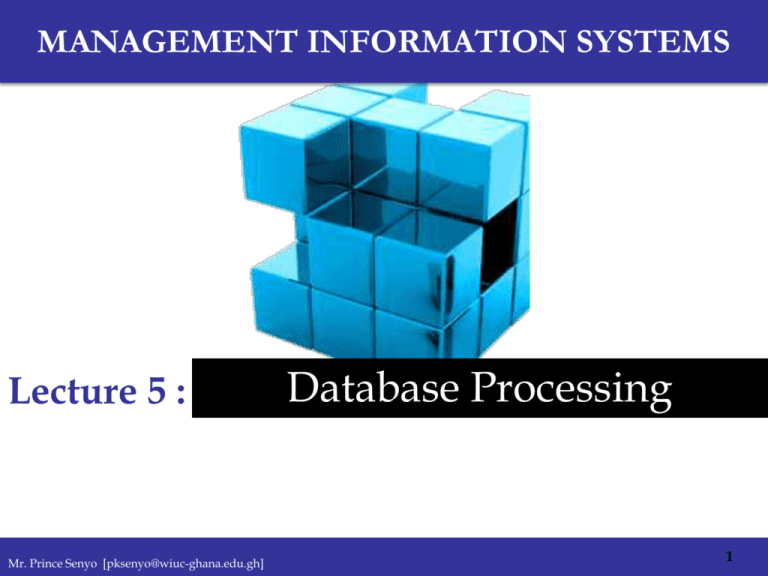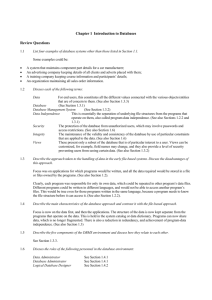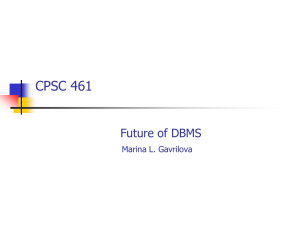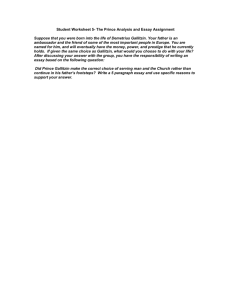
MANAGEMENT INFORMATION SYSTEMS
Lecture 5 :
Mr. Prince Senyo [pksenyo@wiuc-ghana.edu.gh]
Database Processing
1
Class Website
www.blackdecimal.com
Mr. Prince Senyo [pksenyo@wiuc-ghana.edu.gh]
2
Course Textbooks - Recommended
Mr. Prince Senyo [pksenyo@wiuc-ghana.edu.gh]
3
Session Objectives
It is expected that at the end of the session, students
will understand:
• What a database is and its purpose in a business
organization.
• What DBMS connotes and its importance in data
storage and manipulation.
• The differences between Database & DBMS.
• What a NoSQL DBMS is.
Mr. Prince Senyo [pksenyo@wiuc-ghana.edu.gh]
4
What is a Database
• A database is a self-describing collection
of integrated records. Hence, a database is
a collection of tables with relationships
among the rows in those tables, with
special data, called metadata, that
describes the structure of the database.
• Relational databases organize data into
two-dimensional tables with columns
and rows. Each table contains data on an
entity and its attributes.
Mr. Prince Senyo [pksenyo@wiuc-ghana.edu.gh]
5
Purpose of Databases
The purpose of a database is to minimizes
the following problems of Data:
• Security
• Redundancy
• Integrity
• Independence
• Isolation,
• Inconsistency (SRI4)
Mr. Prince Senyo [pksenyo@wiuc-ghana.edu.gh]
6
Content of a Database
• A byte is a character of data. Bytes are
grouped into columns.
• Columns are also called field which in
turn, are grouped into rows, which are
also called records.
• The collection of data form all columns is
called a row or a record.
• Finally, a group of similar rows or records
is called a table or a file.
Mr. Prince Senyo [pksenyo@wiuc-ghana.edu.gh]
7
Hierarchy of Data Elements
Mr. Prince Senyo [pksenyo@wiuc-ghana.edu.gh]
8
• The illustration shows a table for the
entity SUPPLIER and how the entity and
its attributes are represented.
• Supplier_Number is the key field.
Mr. Prince Senyo [pksenyo@wiuc-ghana.edu.gh]
9
Establishing Relationships
• Each table in a relational database has one field that is
designated as its primary key. This key field is the
unique identifier for all the information in any row
of the table, and this primary key cannot be
duplicated.
When
the
field
Supplier_Number
appears in the PART
table it is called a foreign
key and is essentially a
look-up field to look up
data about the supplier
of a specific part.
Mr. Prince Senyo [pksenyo@wiuc-ghana.edu.gh]
10
Types of Relationships
• A schematic called an entity-relationship
diagram is used to clarify table
relationships in a relational database.
• The types of entity relationships are
– one-to-one => 1 - 1
– one-to-many = >1 - *
– many-to-many => * - *
• E.g. A relationship between a student and
a program is one to – one since, a student
can enroll in only one program.
Mr. Prince Senyo [pksenyo@wiuc-ghana.edu.gh]
11
Component of a Database
• Formal term for table
is “relation”. Linking
relations
together
creates relationships.
• A database is a group
of related tables.
• Metadata describes
the definitions of the
tables, fields and
relationships.
Mr. Prince Senyo [pksenyo@wiuc-ghana.edu.gh]
12
What is DBMS
• Database Management System (DBMS) is
a set of programs that provide users with
tools to add, delete, access, modify, and
analyse data stored in a central location.
• Popular DBMS products are DB2 from
IBM, Access and SQL Server from
Microsoft, and Oracle from the Oracle
Corporation. Another popular DBMS is
MySQL, an open source DBMS product
that is free for most applications.
Mr. Prince Senyo [pksenyo@wiuc-ghana.edu.gh]
13
• The DBMS relieves the end user or
programmer from the task of understanding
where and how the data are actually stored
by separating the logical and physical views
of the data.
• The logical view presents data as end users
or business specialists would perceive them
whereas the physical view shows how data
are actually organized and structured on
physical storage media, such as a hard disk.
• The database management software makes
the physical database available for different
logical views required by users.
Mr. Prince Senyo [pksenyo@wiuc-ghana.edu.gh]
14
Data Processing
• Four DBMS operations
1. Read
2. Insert
3. Modify
4. Delete data
• The most common data manipulation
language is the SQL.
Mr. Prince Senyo [pksenyo@wiuc-ghana.edu.gh]
15
Enterprise DBMS & Personal DBMS
• Enterprise DBMS products process large
organizational and workgroup databases.
These products support many of users and
many different database applications.
Such DBMS products support 24/7
operations and can manage databases that
span dozens of different magnetic disks
with hundreds of gigabytes or more of
data.
• E.g. IBM’s DB2, Microsoft’s SQL Server,
Oracle’s Oracle, MySQL etc.
Mr. Prince Senyo [pksenyo@wiuc-ghana.edu.gh]
16
Enterprise DBMS & Personal DBMS
• Personal DBMS products are designed for
smaller, simpler database applications.
Such products are used for personal or
small workgroup applications that involve
fewer than 100 users, and normally fewer
than 15.
Mr. Prince Senyo [pksenyo@wiuc-ghana.edu.gh]
17
What is a NoSQL DBMS?
• NOSQL DBMS (NotRelational DBMS
– Supports very high transaction rates
– Relatively simple data structures
– Replicated on many servers in the cloud
• Examples
– Dynamo (Amazon)
– Bigtable (Google)
– Cassandra (Facebook)
Mr. Prince Senyo [pksenyo@wiuc-ghana.edu.gh]
18
Database Administrator
• The Database Administrator is an
individual responsible for creating, &
maintaining databases.
• The functions performed by the
administrator
includes
development,
operation, backup & recovery, adaptation
etc. The administrator uses data
definition language to build and maintain
databases.
Mr. Prince Senyo [pksenyo@wiuc-ghana.edu.gh]
19
Mr. Prince Senyo [pksenyo@wiuc-ghana.edu.gh]
20
References
• David M. Kroenke (2012) Experiencing
MIS. 3rd Edition, Prentice Hall.
• David M. Kroenke (2010) MIS Essentials.
2nd Edition, Prentice Hall.
• Kenneth C. Laudon and Jane P. Laudon
(2009).
Essentials
of
Management
Information Systems. 8th Edition, Pearson
Prentice Hall.
Mr. Prince Senyo [pksenyo@wiuc-ghana.edu.gh]
21
Next Lecture
Data Communications
Mr. Prince Senyo [pksenyo@wiuc-ghana.edu.gh]
22








